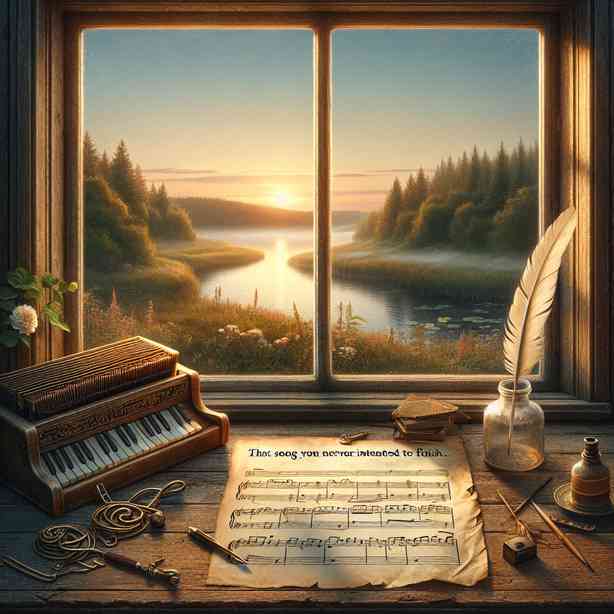
The journey of creativity can often lead to unexpected outcomes, particularly when it comes to music. One such experience is the creation of a song that was never intended to be finished. It’s a tale common among musicians, whether they are seasoned professionals or passionate amateurs. These uncompleted pieces often hold a unique charm that reveals deeper insights into the creative process.
In the realm of songwriting, many musicians embark on a project with a clear vision, only to find their initial ideas evolving in unforeseen ways. The excitement of composing a new melody or exploring fresh lyrics can lead to countless directions. However, amidst this ebb and flow of creativity, many songs might feel incomplete, marred by a sense of dissatisfaction or a lack of direction. So what makes these songs so special, even if they remain unfinished?
The beauty of an unfinished song lies in its potential. It serves as a canvas where dreams and emotions intermingle, capturing a moment in time that reflects the artist’s mindset or experiences. For many creators, these pieces act as snapshots of their artistic journey, filled with raw emotions that might resonate deeply with listeners. The very act of writing, even if the song remains incomplete, holds value in itself—illustrating the exploration of thought, feelings, or stories that need not reach a conventional end.
In a digital age where every song can be recorded and shared within moments, artists often feel the pressure to produce polished work. However, the existence of unfinished songs is a reminder that creation is not always about completion. Sometimes, it’s about self-exploration and the liberation found in expressing oneself. These musical sketches can sometimes share more emotion than as-finished works, reflecting the spontaneity and authenticity often lost in the pursuit of perfection.
Moreover, unfinished songs often become breeding grounds for new ideas. A fragment of a melody might spark a completely new track, or a lyric that didn’t quite fit could lead to explorations in different genres. Artists frequently revisit their unfinished work, rediscovering the emotions attached to it and finding new pathways in their creative journey. This kind of reflection is crucial; it allows for personal growth and artistic evolution.
Many famous musicians have songs they never finished, yet those pieces have become legends in their own right. Bob Dylan, for instance, has a treasure trove of unreleased and unfinished tracks that give fans a glimpse into his evolving artistry. Similarly, the Beatles left behind a variety of unfinished songs, offering rare insights into their creative processes. These pieces may not have been completed, but they resonate with audiences, often eliciting a unique connection and sparking discussions about potential meanings and directions that could have been taken.
One might wonder, then, if there is any value in dedicating time to unfinished songs. Absolutely. Engaging with these pieces can be a profound learning experience. They teach artists about their own preferences, strengths, and weaknesses. An unfinished song can highlight what inspires the artist, showing them what moves them to create. In this sense, an incomplete piece of music serves not just as an artistic endeavor but also as a personal journey, helping to define an artist’s unique voice and style.
Furthermore, there are a variety of methods artists can use to approach their unfinished songs. Some may choose to showcase these pieces in raw form, giving audiences a glimpse into their creative process. Others may take the opportunity to collaborate with fellow musicians, allowing fresh perspectives to guide the completion of the song. It can also be beneficial to simply revisit the work after some time, allowing the artist to grow into their voice and offering a chance to reflect on how their ideas have changed.
In any case, it often seems that the process is equally important as the product. This is especially true in an age that frequently prioritizes output over introspection. The stories behind unfinished songs can illuminate personal growth and artistic evolution, making them an essential part of the creative narrative.
So, what can we learn from these unfinished songs? They teach us about patience and perseverance in the creative process. They remind us that creativity is not a race; rather, it’s a journey filled with twists and turns, moments of inspiration, and instances of uncertainty. Each unfinished piece tells a story in its own right, and sometimes those stories hold more depth than a fully formed product.
As we wrap up this exploration of songs never intended to be finished, it’s important to embrace the myriad possibilities that reside within every creative endeavor. The essence of an unfinished song lies in its capacity to evoke thought, emotion, and connection. Through acknowledging and celebrating these creations, artists continue to grow and inspire, illustrating that the creative process itself is often more significant than the final result.
In conclusion, the tale of never finishing a song opens doors to understanding the complexities of the artist’s journey and the beauty that can be found in uncertainty. Instead of viewing these pieces as failures or incomplete thoughts, we can appreciate them as essential parts of an evolving story—both for the artist and the audience. This powerful relationship between the creative work and its context enriches our understanding of music and the emotional truth that lies behind every lyric and note. Understanding this dynamic can inspire not just artists but also listeners who find resonance in the profound experience of art in its many forms. Embrace the unfinished, for within it lies a world of possibilities waiting to be explored.


